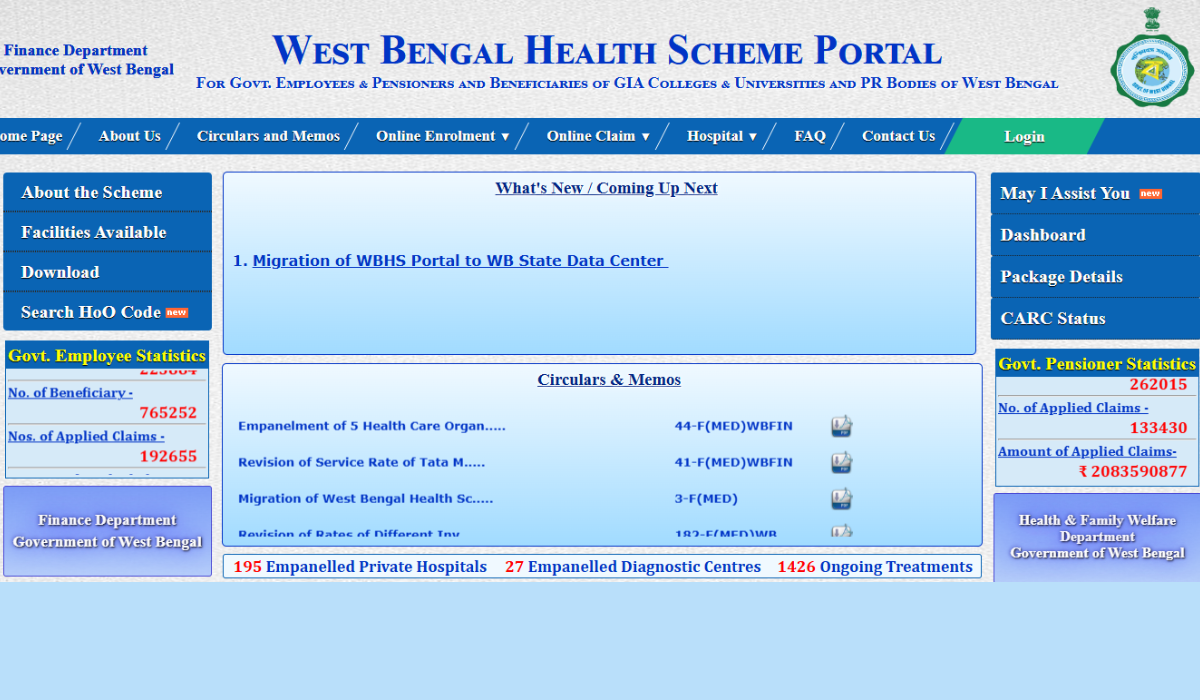West Bengal Health Scheme: A Lifeline for State Government Employees and Pensioners
Healthcare is a basic need, and when it comes to the wellbeing of government employees and pensioners, it becomes even more crucial. Recognizing this, the Government of West Bengal launched the West Bengal Health Scheme (WBHS), a comprehensive medical benefits program aimed at providing quality healthcare services to state government employees, pensioners, and their families. This scheme has been a significant step toward ensuring financial and medical security for those who have served the government.
What is the West Bengal Health Scheme?
The West Bengal Health Scheme was initially introduced in 2008 and revamped in 2014 as the West Bengal Health for All Employees and Pensioners Cashless Medical Treatment Scheme. The aim was to offer cashless and reimbursement-based medical treatment for specified diseases and surgeries in government and empaneled private hospitals across India.
It provides a safety net by covering major medical expenses, which are often a burden for middle-income government employees and retirees. The scheme has helped thousands of families avoid financial hardship during medical emergencies.
Who Can Avail the Benefits?
The scheme is open to:
- Serving West Bengal Government employees
- Retired state government pensioners
- Family pensioners
- Beneficiaries under the All India Service (AIS) cadre
Their dependent family members are also eligible for coverage under the scheme. Dependents include spouses, children (unmarried and financially dependent), and parents who are not employed or earning.
Key Features of the WB Health Scheme
Let’s take a quick look at the core features of this health scheme:
- Cashless Treatment up to ₹1,00,000 per Indoor Treatment: Empaneled hospitals provide cashless treatment for eligible diseases up to ₹1 lakh per hospitalization. If the cost exceeds the limit, the balance can be claimed through reimbursement.
- Wide Network of Hospitals: Beneficiaries can avail treatment from government hospitals as well as private hospitals that are empaneled under the scheme. Some private hospitals outside West Bengal are also included.
- Reimbursement Facility: For treatments not covered under the cashless provision or taken in non-empaneled hospitals, reimbursement can be claimed as per approved rates.
- Outpatient Treatment for Certain Diseases: Chronic illnesses like cancer, diabetes, heart diseases, and kidney problems also fall under outpatient treatment coverage in selected facilities.
- Online Portal for Easy Access: A dedicated website wbhealthscheme in offers online registration, hospital list, treatment packages, claim submission, and tracking.
How to Enroll in the Scheme?
For employees and pensioners, the enrollment process is quite simple:
- Visit the official WBHS portal.
- Select the “Enroll” option and fill in the required personal and employment/pension details.
- Submit the form online and get a unique WBHS ID.
- Print the Health Card which can be used for cashless treatments.
Some departments also facilitate offline enrollment through HR or DDO offices.
List of Empaneled Hospitals
The scheme includes a growing list of government and private hospitals across West Bengal, including reputed names like:
- Apollo Gleneagles Hospital, Kolkata
- Fortis Hospital, Anandapur
- AMRI Hospitals
- Ruby General Hospital
- Medica Superspecialty Hospital
Hospitals outside West Bengal like AIIMS, New Delhi, and Christian Medical College, Vellore, are also part of the empaneled list for super-specialty treatments.
Conclusion
The West Bengal Health Scheme is a forward-thinking initiative that reflects the state government's commitment to the health and welfare of its employees and pensioners. With features like cashless hospitalization, a wide hospital network, and a user-friendly digital platform, the scheme has truly made medical care more accessible and affordable.
For any government employee or pensioner in West Bengal, enrolling in the WBHS is not just an option—it’s a smart move toward securing a healthier future. Whether it's a sudden medical emergency or the ongoing treatment of chronic conditions, this scheme ensures that financial constraints never come in the way of quality healthcare.





Comments